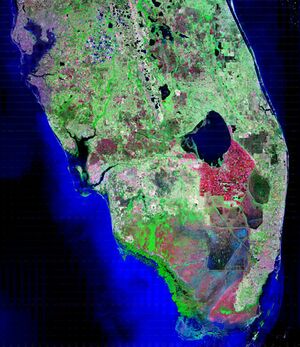Florida (U.S. state): Difference between revisions
imported>Donald Albury (→Politics: add reference section) |
imported>Donald Albury (→History: Ponce de Leon) |
||
| Line 7: | Line 7: | ||
Florida has been occupied for 14,000 years, beginning with the arrival of | Florida has been occupied for 14,000 years, beginning with the arrival of | ||
[[Paleo-Indians]]. Around 8000 BC the paleo-indian culture was replaced by, or evolved into, the Archaic culture. Large shell [[middens]] and purpose-built [[mound]]s appeared beginning around 3000 BC, and fired pottery appeared in Florida by 2000 BCE. By about 500 BCE, the Archaic culture that had been fairly uniform across Florida began to fragment into regional cultures. At the time of first European contact, many different languages were spoken and many different, though related, cultures were practiced in Florida. The cultures of the Florida panhandle and the north and central Gulf of Mexico coast of the Florida peninsula were strongly influenced by the mound-building cultures of the Mississippi Valley, but retained a distinctive character. [[Maize]] was cultivated in the panhandle and the northern part of the peninsula, but agriculture in general was absent or very restricted in the tribes that lived in the southern half of the peninsula.<ref>Milanich. (1998) P. 3-132</ref> | [[Paleo-Indians]]. Around 8000 BC the paleo-indian culture was replaced by, or evolved into, the Archaic culture. Large shell [[middens]] and purpose-built [[mound]]s appeared beginning around 3000 BC, and fired pottery appeared in Florida by 2000 BCE. By about 500 BCE, the Archaic culture that had been fairly uniform across Florida began to fragment into regional cultures. At the time of first European contact, many different languages were spoken and many different, though related, cultures were practiced in Florida. The cultures of the Florida panhandle and the north and central Gulf of Mexico coast of the Florida peninsula were strongly influenced by the mound-building cultures of the Mississippi Valley, but retained a distinctive character. [[Maize]] was cultivated in the panhandle and the northern part of the peninsula, but agriculture in general was absent or very restricted in the tribes that lived in the southern half of the peninsula.<ref>Milanich. (1998) P. 3-132</ref> | ||
Juan Ponce de León is usually credited with the discovery of Florida, although he may not have been the first Spainard to reach Florida, as he reported an encounter with a Spanish-speaking Indian on the southwest coast of the peninsula later in his voyage. De León landed on Florida on April 2, 1513, somewhere on the northwest coast of the present state of Florida, and claimed the land for Spain. He named the new land ''La Florida'', Spanish for ''flowery''.<ref>Smith and Gottlob</ref> | |||
Prior to American acquisition, Florida was controlled by [[Spain]]. In 1845 it became a state of the United States. During the [[American Civil War]], Florida seceded and joined the [[Confederate States of America]] but was regained by the Union after the war. | Prior to American acquisition, Florida was controlled by [[Spain]]. In 1845 it became a state of the United States. During the [[American Civil War]], Florida seceded and joined the [[Confederate States of America]] but was regained by the Union after the war. | ||
Revision as of 15:48, 13 August 2007

Florida is a state of the United States, located in the extreme southeast part of that country. Geographically, Florida is a peninsula largely surrounded by water. The eastern coast borders the Atlantic Ocean, while the western coast touches the Gulf of Mexico. Both coasts represent the longest U.S. coastlines on those respective bodies of water. To the north, Florida is bordered by a succession of southern states, Mississippi, Alabama, and Georgia. The capital of Florida is Tallahassee, while the largest city by population is Jacksonville. Other significant locations in Florida include the cities of Miami, Tampa, and Orlando, which is home of the Walt Disney World complex of resorts and theme parks.
History
Florida has been occupied for 14,000 years, beginning with the arrival of Paleo-Indians. Around 8000 BC the paleo-indian culture was replaced by, or evolved into, the Archaic culture. Large shell middens and purpose-built mounds appeared beginning around 3000 BC, and fired pottery appeared in Florida by 2000 BCE. By about 500 BCE, the Archaic culture that had been fairly uniform across Florida began to fragment into regional cultures. At the time of first European contact, many different languages were spoken and many different, though related, cultures were practiced in Florida. The cultures of the Florida panhandle and the north and central Gulf of Mexico coast of the Florida peninsula were strongly influenced by the mound-building cultures of the Mississippi Valley, but retained a distinctive character. Maize was cultivated in the panhandle and the northern part of the peninsula, but agriculture in general was absent or very restricted in the tribes that lived in the southern half of the peninsula.[1]
Juan Ponce de León is usually credited with the discovery of Florida, although he may not have been the first Spainard to reach Florida, as he reported an encounter with a Spanish-speaking Indian on the southwest coast of the peninsula later in his voyage. De León landed on Florida on April 2, 1513, somewhere on the northwest coast of the present state of Florida, and claimed the land for Spain. He named the new land La Florida, Spanish for flowery.[2]
Prior to American acquisition, Florida was controlled by Spain. In 1845 it became a state of the United States. During the American Civil War, Florida seceded and joined the Confederate States of America but was regained by the Union after the war.
Politics
As a Southern state, Florida's politics is generally dominated by conservatives. The current governor is Charles Crist, a member of the Republican Party.
References
- Milanich, Jerald T. Florida's Indians From Ancient Time to the Present. University Press of Florida. 1998.